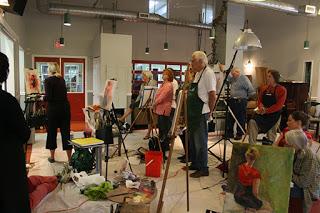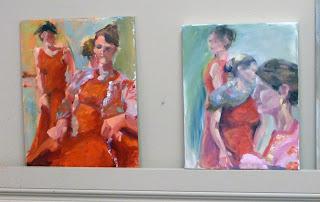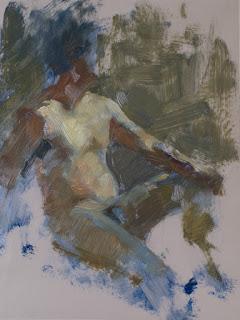
Lee
10 x 8
A couple of weeks ago the Richmond Artist Guild hosted me for a 5-day figure workshop held in the unique Langley cohousing facility, Windsong. Thanks to artist Lalita Hamill for arranging the venue!
What impressed me about the painters was their long-standing commitment to figure work. Several have been hiring models weekly, and all were clearly used to working from life. That meant that we didn't have to spend time on proportion and how to see and find colours in skin tones, and could proceed to the meat of the matter: interesting paint application, color interactions, and compositional choices. It was an amazingly stimulating group to work with because they really looked at the model and saw her without preconceived notions of what they were looking at. That means that instead of painting a symbols for the features and body parts, they painted them as they really observably were. This sounds like a small matter, but it's huge. Most of us have a set way of depicting a nose, or a hand, that's probably come from our earliest drawings. It's incredibly hard to break out of the habit of those early symbols and see the world without their influence.

Richmond Artist Guild workshop
At home in Calgary, my students at the Calgary School of Art are in the middle of a figure unit which has produced some exciting work. Most recently, I asked them to paint 3 different poses on the same canvas within the 3 hour class. The 20 minute warm up pose was the first one on the canvas and the next 2 had to interact with that first figure in some way. I wanted to see them overlap figures wet in wet (which meant layering paint on the fly), sacrifice favorite passages for the greater good of composition, and work intuitively rather than too rationally. I was looking for lost edges where the model's red dress met the red in another pose or where similar values came together, and I was looking for a sense of perspective in the space, as if the figures were on logical planes. Below are just 2 of many excellent pieces from that experiment. The standing figure in the background of both was the first pose so the other figures were all added later. That's tricky work in wet paint!
Calgary School of Art painters
And, I've taken up painting at a weekly figure drop in. It's long pose work- the model holds a single pose for 3 hours - and I'm loving it. The portrait of Lee at the top came out of last night's session along with the quick sketch on mylar below.Models do us a great service by posing and allowing us to look keenly and long at them without embarrassment or excuses. We are all people watchers, fascinated by our own kind, and models allow us to exercise this fascination and turn it into an act of creation. They give us the opportunity to understand ourselves through them, and to notice the beauty of each person before us.
In a world that's increasingly full of depersonalised interactions - robotic telephone answering services, self check outs, online transactions of all sorts - painting and drawing a real person in a quiet, concentration-filled room, is a deeply satisfying, human thing to do.


